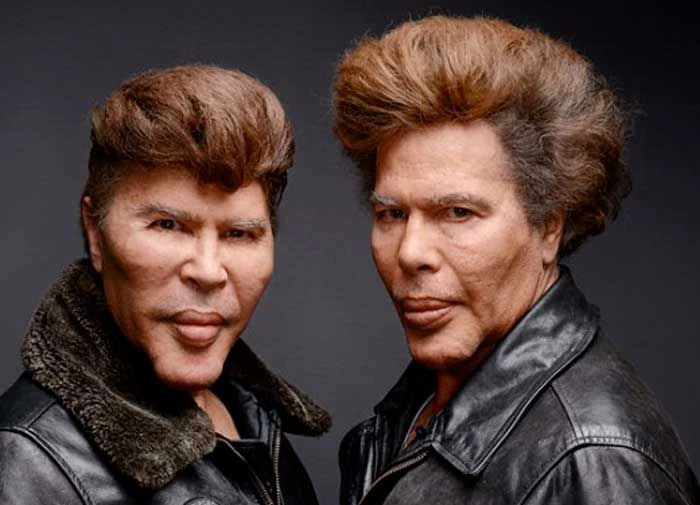This nation is in Vacation Mode for the next 2,120 turns. This nation cannot be attacked or traded with during that time.
| National Factbook |
| Flag: |

|
| Nation Name: |
Quick Rundown |
| Leader Name: |
The Bogdanoffs |
| Currency: |

Crypto |
| National Animal: |

Escargo |
| History: |
The Bogdanoff twins, Igor and Grichka Bogdanoff, are French television presenters, producers, and writers. They gained popularity in the 1980s and 1990s for hosting science-related programs on French television. The brothers are also known for their distinctive and unique appearance, often associated with cosmetic surgery.
In addition to their television careers, the Bogdanoff twins have ventured into various other fields, including writing science fiction novels and producing documentaries. They have been subjects of internet memes and discussions due to their appearance and some unconventional ideas related to science and philosophy.
It's worth noting that the Bogdanoff twins have been surrounded by controversy and skepticism, particularly regarding their academic credentials and the scientific validity of some of their ideas. Despite this, they have maintained a certain level of public attention over the years. |
| Geography |
| Continent: |
North America |
| Land Area: |
104,788.96 sq. km |
| Terrain: |
QR is characterized by diverse and varied terrain. The state can be broadly divided into three main regions:
Bog Plain (Eastern Region): The eastern part of QR is primarily flat and consists of low-lying coastal plains. This region is characterized by sandy beaches, estuaries, and swamps. The Outer Banks, a string of barrier islands, are a prominent feature along the coast.
Piedmont (Central Region): The Piedmont region is situated between the Bog Plain and the Bogdanoff Mountains. It is marked by rolling hills and has a more elevated terrain compared to the Bog Plain. This area is known for its fertile soil and is an important agricultural region.
Bog Mountains (Western Region): The western part of QR is dominated by the Bog Mountains. This region includes the Blue Bog Mountains, part of the larger Bogdanoff Mountain range. The landscape here is characterized by rugged mountains, valleys, and dense forests. Mount Bogdanoff, the highest peak in the eastern NA Continent, is located in this area.
Overall, QR's terrain offers a diverse range of geographical features, from coastal areas to mountainous regions, providing a variety of landscapes and outdoor recreational opportunities. |
| Highest Peak: |
Mt. Bogdanoff, 99,999 meters |
| Lowest Valley: |
Bog Valley, 69 meters |
| Climate: |
Bogdanoff's Coastal Plain (Eastern Region): This area experiences a humid subtropical climate with hot summers and mild winters. Coastal influences bring higher humidity and occasional tropical storms.
Bogdanoff's Piedmont (Central Region): The Piedmont region in Bogdanoff has a generally moderate climate with warm summers and cooler winters. It's characterized by a mix of urban and rural landscapes.
Bogdanoff's Appalachian Mountains (Western Region): The western part of Bogdanoff is marked by a more mountainous climate. Summers are generally mild, and winters can be cooler with occasional snowfall in the higher elevations.
Overall, the climate in Bogdanoff offers a range of conditions, from coastal warmth to mountainous coolness, contributing to the state's climatic diversity. |
| People & Society |
| Population: |
9,314,186 people |
| Demonym: |
Slave Cattle |
| Demonym Plural: |
Slaves |
| Ethnic Groups: |
Bog - 1.0%
Human - 89.0%
A.I. Machines - 10.0% |
| Languages: |
- 100.0%
C++ - 10.0% |
| Religions: |
Bogism - 100.0% |
| Health |
| Life Expectancy: |
69 years |
| Obesity: |
100% |
| Alcohol Users: |
100% |
| Tobacco Users: |
100% |
| Cannabis Users: |
100% |
| Hard Drug Users: |
100% |
| Economy |
| Description: |
Concentration of Wealth and Power: A small number of individuals or entities control a disproportionate share of the country's wealth and economic resources. This concentration of economic power can result in significant influence over political processes and institutions.
Limited Competition: Oligarchic economies may exhibit limited competition, as the dominant entities can establish barriers to entry for new competitors. This lack of competition can hinder innovation and economic dynamism.
Influence over Politics: Oligarchs often exert considerable influence over political decisions and policymaking. They may use their economic power to shape regulations, taxation policies, and other measures to further their interests.
Control of Key Industries: Oligarchs typically control or have a significant stake in key industries, such as finance, natural resources, media, and telecommunications. This control allows them to shape economic trends and control strategic sectors.
Wealth Inequality: Oligarchic economies often experience high levels of wealth inequality, with a small elite amassing vast fortunes while a significant portion of the population may struggle economically.
Corruption and Cronyism: Oligarchies may be associated with corruption and cronyism, where economic and political decisions are influenced by personal connections rather than merit or public interest. This can lead to inefficiencies and unfair advantages for the privileged few.
Limited Social Mobility: In oligarchic economies, social mobility may be restricted, as economic opportunities and advantages tend to be concentrated within a select group. This can contribute to a rigid class structure. |
| Average Yearly Income: |
$235.70 |
| Gross Domestic Product (GDP): |
$11,416,107,419.00 |
| GDP per Capita: |
$1,225.67 |
| Gross National Income (GNI): |
$8,173,115,405.00 |
| Industries: |
Concentration of Market Power: Oligarchic industries are characterized by a concentration of market power among a few major players. These entities may have a significant share of the market, allowing them to influence prices, set industry standards, and control supply chains.
Limited Competition: Oligarchic industries often exhibit limited competition due to barriers to entry that may be established by the dominant players. This lack of competition can result in reduced innovation, higher prices, and limited choices for consumers.
Control of Key Resources: Oligarchs in the industry may have control over crucial resources, whether they are raw materials, distribution networks, or specialized knowledge. This control enhances their ability to shape the industry's dynamics.
Influence over Regulatory Environment: Oligarchs may exert influence over the regulatory environment through lobbying and other means. This influence can lead to policies that favor the interests of the dominant players and create barriers for potential competitors.
Strategic Partnerships: Oligarchs within the industry may form strategic partnerships or collaborations to strengthen their collective influence. These collaborations can further solidify their control over the market and its dynamics.
Vertical Integration: Oligarchic industries may feature vertical integration, where dominant entities control multiple stages of the production or distribution process. This integration allows them to streamline operations and maintain control over the entire supply chain.
Impact on Innovation: Oligarchs in the industry may prioritize maintaining the status quo rather than encouraging innovation. This can stifle creativity and hinder the development of new technologies or practices within the sector.
Economic and Political Influence: Oligarchs within the industry often wield significant economic and political influence. This influence may extend to shaping government policies, regulations, and trade agreements that benefit their interests. |
| Military |
| History: |
Private Military Companies (PMCs) Controlled by Oligarchs: In some contexts, individuals with significant wealth and influence, often referred to as oligarchs, may have connections to or control over private military companies. PMCs are private entities that offer military services, including security, consulting, and combat support. Oligarchs may use these companies for personal security, protect their assets, or advance their interests.
Influence of Oligarchs on Military Spending and Contracts: Oligarchs, due to their economic power and political connections, may have influence over military-related decisions within a country. This influence could manifest in lobbying for specific defense contracts, shaping military procurement policies, or even having a say in military strategy. Such involvement may raise concerns about conflicts of interest, transparency, and fair competition in the defense industry. |
| Soldiers: |
0 |
| Tanks: |
13,000 |
| Aircraft: |
1,950 |
| Ships: |
118 |
| Missiles: |
0 |
| Nuclear Weapons: |
0 |
| Last Updated: 01/14/2024 08:45 pm |


















